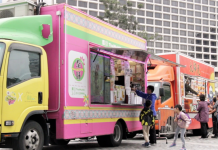Wheelchair users struggle to access restaurants in Hong Kong
Reporters: Civi Yap, Gloria Li, Tommy Yuen
Editors: Katie Cheng, Nancy Mak
From street-stalls to dim-sum houses, local style diners, to fine-dining and themed restaurants in shopping malls – Hong Kong has it all. It’s not known as a food paradise for nothing. But for those who use wheelchairs, going out to sample the delicacies offered in this paradise is not so easy.
Ho Yuen-kei is a food blogger who writes food reviews based on her experience as a wheelchair-user. Ho says not all Hong Kong eateries are accessible. “Some small shops have steps so my wheelchair can’t get in them. Apart from that, it’s small and cramped, I might block someone if I parked my wheelchair inside the shop,” she says.
In 2008, the Buildings Department revised the Design Manual-Barrier Free Access to set design requirements for providing accessible facilities in buildings for people with disabilities or special needs. These state the specifications for mandatory barrier-free facilities in buildings, including the width of corridors and the gradients of ramps. However, even with regulation and clearly defined standards, there are still problems.
One is that the requirements only apply to buildings constructed after 2008, and it is hard to retrofit older buildings. According to a survey on barrier-free facilities in Kwun Tong District conducted by Hong Kong Federation of Handicapped Youth and the Kwun Tong District Council in 2013, more than 20 per cent of a total of 375 items surveyed, including entrances, ramps, staircases, counters, lifts and toilets, were found to deviate from the guidelines listed in the 2008 manual.
Another problem is that restaurants and shopping malls may do the bare minimum to meet the official requirements, but have no interest in or commitment to serving the needs of people with disabilities. Yuen Lai-chuen, a member of Direction Association for the Handicapped, says wheelchair-users often have to take freight lifts because few buildings and restaurants provide lifts that will accommodate disabled customers.
Some groups are acting to try and change the wheelchair-unfriendly environment in Hong Kong. Freeguider is an online platform which provides information on local wheelchair-friendly venues. Content on the site is based on the first-hand experiences reported by the site’s ‘surveyors’ who are wheelchair users who make trips to the venues. The surveyors will evaluate the degree of wheelchair-friendliness of various facilities at a venue, such as the entrances, passageways, lifts and disabled toilets. Photos and specific details are shared on the Freeguider App and website.
Raymond Tang, one of the Freeguider surveyors, says most of his experiences in local restaurants are unsatisfactory due to a lack of public awareness about the needs of people with disabilities. He observes that many disabled toilets are locked or cluttered with stuff. Also, restaurant staff often fail to offer to help customers with disabilities even when they see them running into barriers at the entrances of restaurants. “Although Hong Kong labels itself as an integrated society, the facts do not bear that out,” Tang says.
Merely improving the hardware and facilities is not enough to create a truly accessible environment. Fiona Wat, the director of Our City Love project, trains restaurant staff to increase their awareness, knowledge and skills to better take account of and care for people with special needs. She thinks this kind of “software” matters as well. “That is the empathy we have for others, which can be cultivated through education to motivate people to help each other,” she says.
Rabi Yim, the president of Direction Association for the Handicapped, encourages people to put themselves in others’ shoes to build an inclusive society. “Imagine yourself or your family member in the wheelchair, with the true understanding that comes from the heart, you’ll find the conditions are very different,” Yim says. “Everyone has the right to enjoy food.”









































